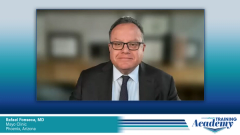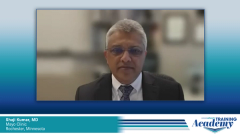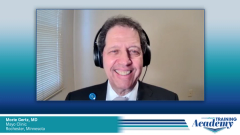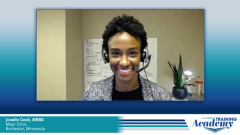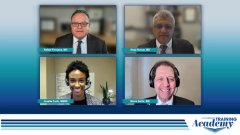
Insights from Experts at Mayo Clinic: Step-up and Treatment Dosing of Bispecifics
A panel of key opinion leaders from Mayo Clinic reflect on optimizing use of bispecifics in relapsed/refractory multiple myeloma, reviewing step-up dosing, administration, and followup strategies.
Episodes in this series

Transcript:
Rafael Fonseca, MD: Shaji, how are you doing step-up dosing and administration? Morie mentioned some of the remote monitoring we have. Would you mind explaining how we’re doing this?
Shaji Kumar, MD: Obviously, the main concern with the bispecific antibodies is cytokine release syndrome [CRS]. That’s the reason behind the suggestion that these patients should be hospitalized for administration. The dosing schema for teclistamab calls for 2 smaller doses to be given on day 1 and day 4, and then you get the full dose at the beginning of week 2. With step-up dosing, there has to be an observation period. We’ve been able to successfully do this because we had a long-standing outpatient transplant program. It was much easier for us to develop a remote patient-monitoring setup, even in the setting of something like teclistamab. We’ve been doing some of this in the context of CAR [chimeric antigen receptor] T-cell therapy studies and in the clinical use of CAR T-cell therapy.
Essentially, patients have a device on that will allow us to monitor their heart rate, temperature, and other vitals like blood pressure and oxygen saturation). Patients are seen every day in an outpatient setting. We have a robust outpatient practice that allows us to monitor these patients very closely. Patients are staying in town. We gently tell patients to stay within 15 to 20 minutes of the medical center for at least the first week or 2. During this time, they’re enrolled in remote patient monitoring, which allows for us to monitor between these daily visits. When they’re seen daily, we can collect a lot more data in terms of physical examination, neurological symptoms, and so forth. It’s a combination of remote data collection, daily assessment face-to-face, and individual reporting of new symptoms from patients that lets us do the remote patient-monitoring approach as an almost entirely outpatient practice. Of course, if patients develop any evidence of CRS, we can easily admit them as inpatients because of the setup we have. This has been successful with teclistamab, but we’ve also been doing this with CAR T and bispecifics for some time. Many colleagues have presented data at various meetings.
Morie Gertz, MD: [I want to give] some nuts and bolts for the audience. What happens is the patient gets an iPad Mini. The oximeter and blood pressure device—they’re taking measurements themselves—are Bluetooth-enabled devices. They’re not calling a nurse to say, “My blood pressure is this.” They take their measurements, and then telemetry automatically sends it to the nurse. The nurse has all the prior measurements as well so that they can intervene. This is exactly as Professor Kumar said, but the setup is pretty slick in terms of the patient’s ability in a hotel room to send instantaneous critical information, such as gaining weight through fluid retention. If they’re developing tachycardia, it doesn’t do rhythm. But if you’re 130 beats per minute, that can’t be good. It’s an impressive setup.
Rafael Fonseca, MD: We’re very fortunate that our institution [Mayo Clinic] saw the wisdom of remote monitoring. For those who don’t know, we have a remote hospital. The control center is in Florida for a lot of these activities, and we’re building on remote monitoring. It’s interesting because Phoenix is a little more extensive, so we give them 30 minutes—15 to 20 minutes is probably the bulk of what you need in Rochester, although maybe we should consider the snow in the winter. Morie, you talked about transition of care, community doctors, and how that’s working. You mentioned the economics as well, but can you expand a little on that?
Morie Gertz, MD: The big thing for me is the educational barrier. For CAR T and for teclistamab, you have to be a registered provider. You can’t just write the prescription and give it. To become a registered provider, you need to take an online course of mastery. The key is that many practicing oncologists who finished training have never heard of cytokine release syndrome and ICANS [immune effector cell-associated neurotoxicity syndrome]…. That’s a real barrier to implementation in the community setting if they’ve never given tocilizumab or managed ICANS. That educational barrier needs to be taken care of because ICANS can occur late and can be serious—recognition and early intervention become an issue.
The oncologists I’ve talked to are really enthusiastic. They want to be able to give bispecifics in the community setting, but it’s a little overwhelming because they’ve never treated cytokine release syndrome. The first time they give tocilizumab—Is it grade 1 and I’m going to sit on it, or is it a grade 2 but hemodynamically stable? When am I going to pull the trigger?—can be very challenging if they didn’t have that exposure in training. That’s another barrier. Our sense with bispecifics is that you give 2 to 3 doses. We should have cleared most of the hurdles, and then they’ll be able to give outpatient administration. All those reimbursement issues don’t come and are ready to go.
Rafael Fonseca, MD: Thank you. To expand a little, what do you think about prophylactic medications or early use of some of the preventive treatment medications that can be used for CRS?
Morie Gertz, MD: We have to be awfully careful and rely on the trials first. Obviously, there have been trials showing that you give tocilizumab even before day 0 abrogates it, but we don’t have long-term response data. I get pretty nervous because I wonder if part of cytokine release syndrome kills multiple myeloma. It makes me nervous. It’s like saying, “We can completely abrogate graft-vs-host disease [GVHD],” but those of us who do allogeneic transplant know that’s not such a good idea because we have to have a little GVHD. I’m nervous about being outside a trial and trying to abrogate cytokine release syndrome until we have data to indicate it won’t impact response duration and depth.
Rafael Fonseca, MD: That’s a great analogy of how we could think about this. Obviously, we need long-term data. Dr Cook, is there anything else you want to add regarding the practices and practicalities from what you have seen in your practice?
Joselle Cook, MBBS: No, Dr Gertz and Dr Kumar hit the nail on the head on all points. We’re seeing more community practices want to do bispecific agents because of the same barriers that we discussed with CAR T. Coordination of care, communication with them, having them understand what to look for, and mitigation processes with tocilizumab are all important things that we need to communicate with the patient and their home care team.
Transcript edited for clarity.
Newsletter
Stay up to date on recent advances in the multidisciplinary approach to cancer.


